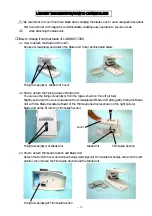
P
AGE
3
OF
26
DGF100
reference
manual, rev 1, Feb 22, 2022
Ground
Fault
Systems
B.V.
1.
G
ENERAL
DESCRIPTION
The DGF100 is a microprocessor based ground fault unit for use on solidly grounded or resistance
grounded systems. This innovative digital electronic unit measures ground fault current using a built-in
46 mm zero sequence Current Sensor (CS), or an external Current Sensor. External Current Sensors with
different cable windows, round or square, and various current ratios are available. The external current
sensors must be connected to terminals T1 & T2.
The system will react to alternating current (ac) only and will reject direct current (dc) signals. Accuracy
will be maintained over a frequency range of 40-65 or 400 Hz, making it suitable for variable frequency
drive applications. The DGF100 is a Class A device as defined in the IEC 60755 standard; it is therefore
fully characterized for operation with sinusoidal ac and pulsating dc currents.
The DGF100 houses an isolated universal power supply from 24-240 V ac or dc and is equipped with form
‘Z’ (4-wire) isolated N.O and N.C. contacts. The Ground Fault (G/ F) Current Trip level (30mA-9A, 14
steps), Trip Delay Time (20ms–5s, 8 steps) and the Relay Operating Mode (F/S, non-F/S, pulsed auto
reset and pulsed Non-FS) are set on a front accessible dipswitch array.
A single press of the RESET button, or an external, voltage free, momentary pushbutton connected to
terminals R1 and T2/R2, resets the relay after a trip. A functional test of the DGF100 is started by either
double clicking the cover mounted or external button, or by invoking a test on the DGF100 Display.
A green RUN LED flashes, alternating one second on and off, to indicate that sufficient control power is
applied to terminals L+ and N- (Power OK).
A red TRIP LED indicates that the DGF100 has sensed a Ground Fault and that the output contacts have
operated.
7 point and 3 point pull-apart terminal blocks simplifies connection of field wiring. A captive screw
secures the 7 point block to the relay, safe from the effects of shock and vibration.
A communications port provides access for a remote display. The remote DGF100 Display shows the
actual ground fault current during normal running of the systems. After a trip the ground fault current
just prior to the trip is displayed. If the DGF100 Display was connected to the DGF100 at the moment of
a trip and the DGF100’s Control Voltage is turned off, pressing the VERIFY button will show a red LED
indicating a ground fault. If no fault was present the green LED will light.
For all features, see the Instruction Manual for the DGF100 Display.
To ensure that the DGF100 will function in all circumstances, it is encapsulated in polyurethane (PUR) to
make sure it is not vulnerable to mechanical shock, vibration nor weather.
The maximum system operating voltage for the DGF100 is 660 V, when passing the system power
conductors through the built-in CS. However, by using any GFS external CS and insulating the busbars, or
by using any suitably rated, commercially available, interposing CT and passing the secondary lead
through the built-in CS, the relay can be used on any system voltage.




































